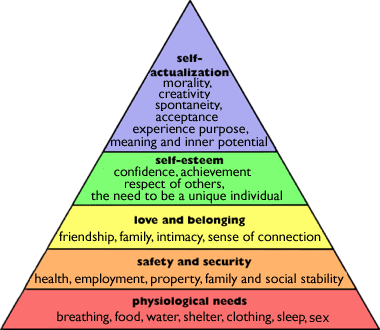 mental
mental
 Consciousness Models
Consciousness Models
 Maslow's hierarchy of needs
Maslow's hierarchy of needs

- Physiological Needs
These include the most basic needs that are vital to survival, such as the need for water, air, food, and sleep. Maslow believed that these needs are the most basic and instinctive needs in the hierarchy because all needs become secondary until these physiological needs are met. - Security Needs
These include needs for safety and security. Security needs are important for survival, but they are not as demanding as the physiological needs. Examples of security needs include a desire for steady employment, health insurance, safe neighborhoods, and shelter from the environment. - Social Needs
These include needs for belonging, love, and affection. Maslow considered these needs to be less basic than physiological and security needs. Relationships such as friendships, romantic attachments, and families help fulfill this need for companionship and acceptance, as does involvement in social, community, or religious groups. - Esteem Needs
After the first three needs have been satisfied, esteem needs becomes increasingly important. These include the need for things that reflect on self-esteem, personal worth, social recognition, and accomplishment. - Self-actualizing Needs
This is the highest level of Maslow’s hierarchy of needs. Self-actualizing people are self-aware, concerned with personal growth, less concerned with the opinions of others, and interested fulfilling their potential.
Maslow's theory was fully expressed in his 1954 book Motivation and Personality.
In the 1970's, Maslow added cognitive and aesthetic needs.
Transcendence was added in the 1990's. Maslow did not explicitly state that Self-Transcendence is a level on the Hierarchy; but his differentiation between self-actualisers and transcenders clearly implies it. Thus, Maslow, in the end, had an 8-level model and a number of psychologists and researchers in the Maslowian tradition - eg: Henry Gleitman, Alan Fridlund & Daniel Reisberg (1999) - have treated the Hierarchy as an 8-Level model..
Source: Keith E Rice - Hierarchy of Needs
- Biological and Physiological needs - air, food, drink, shelter, warmth, sex, sleep, etc.
- Safety needs - protection from elements, security, order, law, limits, stability, etc.
- Belongingness and Love needs - work group, family, affection, relationships, etc.
- Esteem needs - self-esteem, achievement, mastery, independence, status, dominance, prestige, managerial responsibility, etc.
- Cognitive needs - knowledge, meaning, etc.
- Aesthetic needs - appreciation and search for beauty, balance, form, etc.
- Self-Actualization needs - realizing personal potential, self-fulfillment, seeking personal growth and peak experiences.
- Transcendence needs - helping others to achieve self actualization.
Links:
Keith E Rice - Hierarchy of Needs
Maslow's hierarchy of needs | Wikipedia
Hierarchy of Needs | psychology.about.com
Peak Experiences in Self-Actualization: Gifts That Transcend Your Head | space2live
Keith E Rice - Hierarchy of Needs
Quick self-test based on the adapted 8-stage 'hierarchy of needs' at BusinessBalls.com
Spiral Dynamics
Kohlberg's Moral development and Conscience